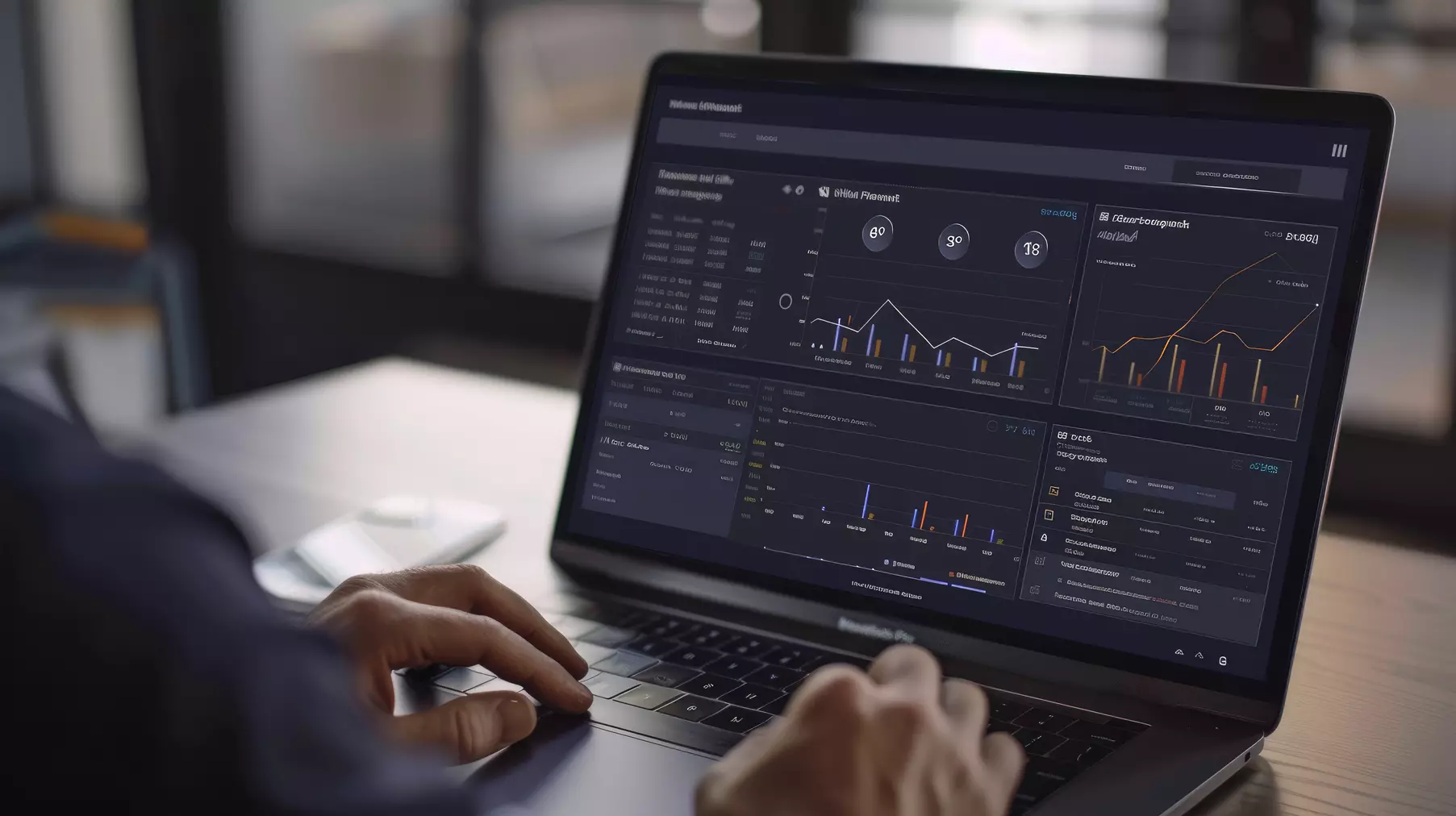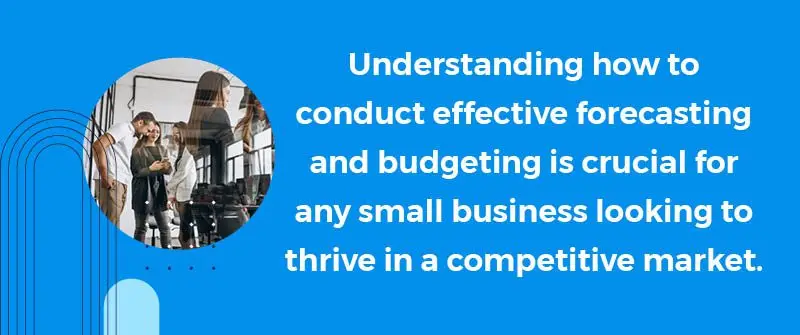
What Is Budgeting And Forecasting Software?
Budgeting and forecasting software for small businesses is a specialized tool designed to assist with the planning, monitoring, and analyzing financial performance. This software integrates various financial processes into a single platform, making it easier for small business owners to track income and expenses, forecast future financial scenarios, and make data-driven decisions. These tools often provide budgeting and forecasting services that help businesses create detailed budgets, project future cash flows, and anticipate financial trends, thereby enhancing overall financial planning and strategy.

Definition and Purpose
At its core, budgeting and forecasting software for small businesses enhances the accuracy and efficiency of financial planning. These tools allow business owners to create detailed budgets based on historical financial data and future projections. By automating workflows and improving collaboration in the budgeting process, the software aids in aligning financial resources with business objectives.
Key Features
Effective financial forecasting software features include real-time data analytics, customizable reports, integration with accounting systems, and user-friendly interfaces. A familiar Excel interface further simplifies financial planning by leveraging a tool that users are already comfortable with. These features simplify financial planning and offer valuable insights to inform strategic decision-making. The software may also offer scenario planning, which enables businesses to simulate various financial outcomes based on different variables.
Benefits for Small Businesses
Small businesses can reap many benefits from using budgeting and forecasting software. These include better financial control, improved accuracy, enhanced strategic planning, and more informed decisions. Automated processes also save time and reduce the risk of human error, making financial management more efficient. Additionally, these tools help finance teams improve collaboration and make faster, more accurate decisions.
Examples of Popular Software
Examples of popular budgeting and forecasting software for small businesses include QuickBooks, FreshBooks, and Xero. Each platform offers unique features tailored to small businesses’ financial needs. Business owners should consider their specific requirements and budgets when choosing the right software.
How To Do Financial Forecasting And Budgeting
Understanding how to conduct effective forecasting and budgeting is crucial for any small business looking to thrive in a competitive market. Both functions are vital in ensuring a business can achieve its financial goals and sustain growth over time.

Setting Financial Goals
The first step in the process is setting clear, attainable financial goals. These goals should align with your overall business objectives and provide a roadmap for your budgeting and forecasting activities. Whether you aim to increase revenue, reduce costs, or improve cash flow, clearly defined goals will guide your efforts and give you a benchmark against which to measure progress.
Collecting Historical Data
Next, gather historical data to form the basis of your forecasts and budgets. This can include past sales figures, expenses, profit margins, and other relevant financial metrics. Accurate historical data is essential for identifying trends and making predictions.
Estimating Revenues and Expenses
With historical data in hand, estimate future revenues and expenses. This estimation should consider market trends, seasonal fluctuations, and any external factors impacting your business. Leveraging financial forecasting software can greatly improve the accuracy of these estimates, providing tools that analyze vast amounts of data to predict future performance. Additionally, incorporating advanced forecasting processes can enhance collaboration and reduce errors, leading to smarter business decisions.
Creating Financial Statements
After estimates are made, the next step is to create financial statements, such as income statements, balance sheets, and cash flow statements. These documents will provide a comprehensive view of your financial health and highlight areas needing adjustment. They serve as the backbone of any effective budgeting and forecasting effort.
Adjusting Forecasts and Budgets
Finally, continuously monitor actual performance against your forecasts and budgets. Adjustments will inevitably be necessary as new data becomes available and circumstances change. This ongoing process will help you remain agile and make data-driven decisions that keep your business on track.
In summary, mastering financial forecasting and budgeting involves a series of systematic steps that, when executed correctly, offer valuable insights and actionable strategies for business growth. Investing in efficient budgeting and forecasting software for small businesses will streamline these processes and improve their accuracy and efficiency.
What Software To Use For Budgeting?
Top Software Options for Small Businesses
The right budgeting and forecasting software is crucial for making informed financial decisions. Some of the top software options tailored for small businesses include:
- QuickBooks: Known for its ease of use and comprehensive financial tools, QuickBooks is an excellent choice for small businesses seeking a reliable budgeting solution.
- Xero: Offering robust features for invoicing, bank reconciliation, and expense tracking, Xero is ideal for small businesses looking for a user-friendly interface.
- FreshBooks: Perfect for service-based businesses, FreshBooks provides efficient time-tracking, project management features, and budgeting tools.
- Sage Intacct: With advanced financial management features, Sage Intacct suits businesses requiring more detailed financial reporting and analysis. It is an enterprise finance platform that unifies financial and operational data; embeds AI for better decisions and productivity, and streamlines budgeting and financial planning processes.

Comparison of Features and Pricing
When selecting the best budgeting and forecasting software, it’s essential to compare features and pricing, especially those related to financial budgeting:
- QuickBooks: With plans ranging from $25/month to $150/month, QuickBooks offers plans to suit different business needs. Key features include automated reports, inventory management, and tax preparation.
- Xero: Starting at $11/month, Xero provides plans that scale with your business size. Notable features include multi-currency support and in-depth financial reporting.
- FreshBooks: With pricing starting at $15/month, FreshBooks is cost-effective for small businesses. It offers customizable invoices and seamless expense tracking.
- Sage Intacct: Pricing is quote-based and tailored to your business. Sage Intacct offers extensive financial management capabilities, making it suitable for more complex financial operations.
User Reviews and Case Studies
User reviews and case studies can provide valuable insights into how these tools perform in real-world scenarios. These tools help optimize business performance by offering financial planning, budgeting, forecasting, and analysis capabilities that enable faster decision-making and improved strategic contributions to company growth activities:
- QuickBooks is lauded for its intuitive interface and powerful integrations. One small business owner noted, “QuickBooks streamlined our financial processes, saving us monthly hours on bookkeeping tasks.”
- Xero users often praise its straightforward setup and excellent customer support. A retail business case study highlighted how Xero’s bank reconciliation feature significantly reduced manual errors.
- FreshBooks consistently receives high marks for its ease of use and customer service. An independent consultant shared that FreshBooks helped them manage client invoicing more efficiently.
- Sage Intacct users appreciate its depth of financial analysis capabilities. A tech startup reported improved financial forecasting and decision-making after implementing Sage Intacct.
Pros and Cons of Each Software
Each budgeting and forecasting software comes with its pros and cons:
- QuickBooks: Pros include comprehensive financial tools and extensive integrations. Cons include higher costs for advanced plans and a learning curve for beginners.
- Xero: The pros are ease of use and scalability. The cons are occasional syncing issues with bank feeds and limited mobile app functionality.
- FreshBooks: Its pros include a user-friendly interface and tailored features for freelancers. Its cons are limited features for product-based businesses and fewer integration options.
- Sage Intacct: The pros are advanced financial management tools and detailed reporting. The cons include higher costs and complexity that are suitable for more established businesses.
How To Do Budget Forecasting In Excel?
Advantages of Using Excel for Forecasting
For many small businesses and startups, using Excel for budget financial forecasting is economical and highly efficient. Excel’s flexibility allows business owners to customize their financial models per their unique business planning requirements. Additionally, Excel is widely utilized, making it an accessible tool for most users familiar with basic computing skills. The absence of costly licenses or subscriptions, common with advanced financial forecasting software, makes Excel an ideal choice for small businesses looking to manage their budget efficiently.

Step-by-Step Guide to Creating a Forecast in Excel
1. Set Up Your Spreadsheet: Create separate columns for periods (months, quarters, years) and rows for categories such as revenue, expenses, and profit. Each section should be clearly labeled for better readability.
2. Input Historical Data: Gather your historical data and input them into respective columns. This data will serve as the foundation for your projections. Ensure your data is consistent and accurate to enhance the reliability of your forecasts.
3. Calculate Averages: Utilize Excel functions like AVERAGE to create baseline projections from your historical data. You can use formulas to calculate growth rates and apply them to forecast future values.
4. Use Scenario Analysis: Excel’s scenario manager allows you to create ‘What-If’ scenarios. This feature is particularly helpful for risk assessment and planning different contingencies.
5. Visualize Data: Create charts and graphs to visualize your data. Graphical representations can help business owners quickly understand trends and patterns in their financial data.
Templates and Tools
Numerous pre-built templates are available for free or at a nominal cost. These templates can significantly reduce the time it takes to set up your forecasting models. Whether you’re forecasting sales, expenses, or cash flows, templates can provide a structured approach that adheres to financial modeling best practices.

Tips and Best Practices
1. Regular Updates: Continuously update your Excel sheets with real-time data to ensure your forecasts remain accurate and relevant.
2. Verify Data Accuracy: Double-check the data inputs and calculations to avoid errors that could compromise your financial planning.
3. Simplify Formulas: Use simple and easily understandable formulas and avoid overcomplicating your spreadsheet. This ensures that anyone who accesses the file can understand and update it as needed.
4. Protect Sensitive Information: Use password protection for your Excel files to safeguard sensitive financial information.
5. Back-Up Data: Regularly back up your Excel files to prevent data loss due to technical issues.
Conclusion
Summary of Key Points
This comprehensive guide discussed the essential aspects of budgeting and forecasting software for small businesses and provided insights into effectively leveraging these tools. We covered the definition and purpose of such software, key features, and examples. We also delved into the step-by-step process of creating and adjusting forecasts and budgets and compared top software options tailored for small businesses. Additionally, we offered practical advice on using Excel for budget forecasting. These elements are crucial for enhancing financial management and achieving business growth.

Importance of Selecting the Right Software
The right financial forecasting software is paramount for accurate financial planning and business strategy. The right software can save time, increase accuracy, and provide valuable insights into financial data. It can help manage cash flows, predict future trends, and align expenditures with revenue goals. For small businesses, especially those on tight budgets, making an informed decision about software can mean the difference between thriving and merely surviving.
Future Trends in Budgeting and Forecasting
The landscape of budgeting and forecasting software is continuously evolving. IBM Planning Analytics is an advanced financial planning and analysis tool that helps finance teams be more strategic and positively contribute to company growth by spending less time on manual, repetitive tasks. Future trends point towards more integrated and intuitive software solutions powered by AI and machine learning. These technologies promise to enhance predictive accuracy and provide deeper data insights. Cloud-based solutions will continue to dominate, offering flexibility and real-time data access. Small businesses should stay informed of these trends to ensure they leverage the most up-to-date tools for their financial planning needs.
Final Recommendations
Evaluating your business requirements, budget, and growth plans is important as you consider the best software for your budgeting and forecasting needs. Look for features that align with your business objectives, and ensure the software can help you assess business performance by providing financial planning, analysis, and reporting tools. Don’t overlook the importance of user-friendly interfaces and robust customer support. Investing in the right software can vastly improve your decision-making capabilities and streamline your financial operations. Check out budgeting and forecasting examples.
Eager to enhance your business growth? Visit Milestone Inc. to see how our specialized budgeting and forecasting services can help your small business thrive. Start planning for success today!
Related Content

What Is Incremental Budgeting?
Find out what incremental budgeting is and how it differs from other budgeting methods. Transform your budgeting process by partnering ...

What Is Financial Planning & Analysis?
Learn about financial planning and analysis to transform your business. Milestone combines deep financial insight with hands-on support so businesses ...

What If Analysis: Definition, Benefits, And How To Perform One
What-if analysis is a strategic decision-making tool used in financial planning to evaluate the impact of various hypothetical scenarios on ...
Stay in the know